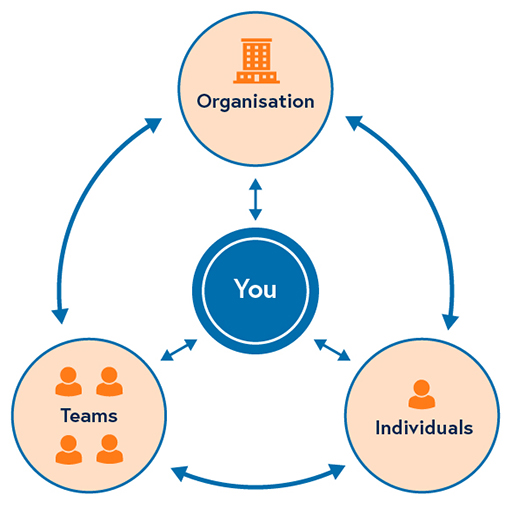4.2 Putting people first
While people have always been at the heart of an organisation it has never been more important to take a human-centred approach to organisational development, change and culture – often referred to as ‘The employee experience’. This may feel challenging because you have to balance the needs of the organisation and the needs of the individuals: you cannot be all things to all people and one size does not fit all, while also considering wellbeing and inclusion.
Adopting a human-centred approach, with a clear communications plan, can help build empathy within an organisation, to create better experiences, and build resilience to and trust in change, so the organisation culture enables confidence to try news ways of working, learn and evolve.
The International Organization for Standardization guidance, which contributes to UN SDG Goals [Tip: hold Ctrl and click a link to open it in a new tab. (Hide tip)] 3 and 8, states that:
‘The term human-centred is used to reflect that organisations not only have an impact on their customers (the users of their products and services), but also on other stakeholders, including their employees, their families, and the wider community.’
The ISO has seven principles that characterise a human-centred organisation. These are outlined below:
| Capitalise on individual differences as an organisational strength | The organisation recognises individual differences as a strength and takes this into account in all areas of its business. The organisation accommodates the nature and extent of individual differences and creates teams of individuals who have complementary skills. |
| Make usability and accessibility strategic business objectives | The human-centred organisation uses International Standards and best practices to ensure that products, systems and services are accessible and usable (effective, efficient and satisfying to use) both by personnel and by other stakeholders. |
| Adopt a total system approach | The organisation recognises that people are part of a comprehensive system, which can include many elements such as equipment, workspace, and the physical, social and organisational environment in which people work and live. These elements interact and are interdependent, and the organisation understands this and acts accordingly. |
| Ensure that health, safety and wellbeing are business priorities | The organisation takes the necessary steps to protect individuals (both inside and outside the organisation) from hazards to their health, safety and wellbeing, and aims to exceed the minimum requirements required by legislation. |
| Value personnel and create meaningful work | The organisation values and acknowledges the contribution that personnel make. It strives to create meaningful tasks for all potential users of the system. The intent for this principle is not to develop a workplace within which a worker simply ‘survives’ (passive vision), but to create an environment within which to live and thrive as a meaningful part of the organisation’s objectives and work. |
| Be open and trustworthy | The organisation benefits from being open and trustworthy through enhanced customer relations (internal and external), user confidence, and increased loyalty, as well as an enhanced reputation. |
| Act in socially responsible ways | The organisation is socially responsible. It behaves ethically and instils pride and confidence in its personnel, customers, and the local community. |
In the next section you will consider how employee expectations have evolved, and how having a human-centred approach may benefit leaders in organisations for developing their ways of working and adapting for digital transformation.

